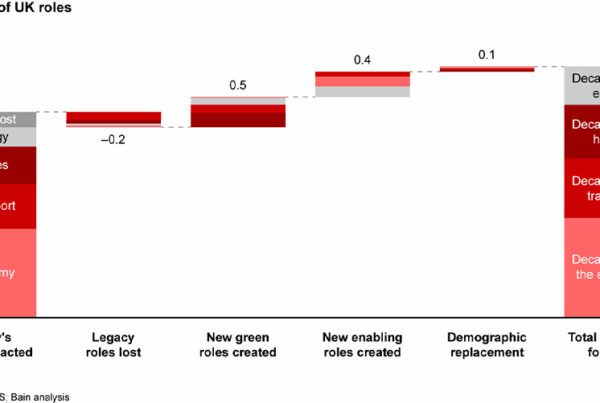Rapid changes are taking place across the global economy and society. As a result, companies are having to transform themselves more often to keep up.
In fact, research conducted by EY and the University of Oxford’s Saïd Business School shows that over the last five years, 85% of senior leaders have been involved in two or more major transformations – but almost 70% are unsuccessful.
Such a high rate of failure is untenable in the intensely competitive environment that exists today, so the question is: how can leaders best position themselves for success?

Prioritise the emotions of employees
Any seasoned executive will tell you that transformation of any kind has a significant impact on employee stress and confidence levels. If leaders want to succeed in their goals, they need to ensure the entire workforce feels supported and engaged throughout the transformation.
The impact that this can have is significant. The research found that leaders who prioritise employees’ emotions during a transformation are 2.6 times more likely to succeed than those who do not. In addition, over half of respondents who were part of a successful transformation said that they received the emotional support they needed throughout the process.
This support can take many forms, such as providing easy access to mental health services and creating safe spaces where issues/concerns can be aired in confidence.

Whether this is achieved via online platforms that connect employees to trained psychologists or through the introduction of regular meetings that are designed to create an environment where employees feel comfortable raising issues without fear or judgement, the important thing is that leadership acknowledges and prioritises employee wellbeing.
Embrace a start-up mindset and culture
Transformation is always a bumpy ride and there will be many roadblocks along the way. In-order to overcome the inevitable challenges as smoothly as possible, leaders must embrace a start-up mindset and culture that encourages employees to share their ideas and experiment with new approaches.
Creating this kind of culture of innovation and collaboration is a key part of the journey that organisations need to go on. Fundamentally, this means being open to new ideas, where leaders are willing to listen to people from all parts of the organisation. And, critically, companies need to demonstrate that these ideas are being taken on board and moved forward.
Doing so will help ensure that the workforce feels valued, empowered and motivated – all of which are critical to the success of any transformation.
Communicate a clear vision
Having and communicating a clear vision for transformation that all stakeholders can believe in is essential and serves as the foundation for any transformation. Key to this is explaining why the transformation needs to take place, not just want needs to happen to achieve it. Almost half of respondents (47%) in a high-performing transformation stated their leader’s vision was clear, inspiring and compelling, versus just 26% of those in a low-performing transformation.
When building this vision, leaders should apply a ‘future-back’ approach. They should ask themselves questions such as, “will my business be relevant in 2, 5 or 10 years?” and “how can I grow our competitive advantage” to create a purpose which will guide their strategy. To be most effective, CEOs need to look both within and outside of their organisation and industry for inspiration to ensure their vision is truly compelling.

Invest in the right technology and talent
Investing in the right technology and talent is critical for leaders to get right, as both these elements will help to bring the overall transformation to life.
Having the most effective technology will be key to driving efficiencies and allowing the workforce to focus on more strategic elements of the business. It’s therefore perhaps unsurprising that almost 50% of employees in a successful transformation said that their organisation had invested in the right technologies, compared with 33% for underperforming transformations.
But it’s important to remember that technology alone is not enough. For optimal results, tech needs to work in collaboration with talent. This can be a delicate balance and leaders have a responsibility both to educate their employees on the benefits of a tech-enabled approach and the value that can be added without threatening their employment, as well as to ensure the necessary skills are in place to ensure that the technology is applied effectively.
While this typically requires a combination of upskilling and recruitment, it’s key to get the workforce comfortable with the concept of the technology from the outset and creating advocates who can help endorse this coordinated approach.

Align the leadership style
Leadership is a skill and one that requires constant refinement. Every executive should therefore experiment with their leadership style, even if this is a daunting prospect. It requires some introspection – an analysis of their limitations, acknowledgement that they might not have all of the answers and a willingness to shift their approach, if necessary.
While showing this kind of vulnerability may be intimidating, doing so will help to identify where opportunities lie and build a genuine rapport with employees who typically respect those who are willing to show their human side.
Beyond this, leaders should be transparent with employees about the direction of the transformation. A two-way dialogue is important and leaders need to constantly listen to their team and act on the feedback they receive. They must not, under any circumstances, allow themselves to become isolated.
Change is never easy and there will be many twists and turns along the way. But the reality is that change is essential, and it’s happening at a faster rate now than ever before. Businesses today need to exist in a constant state of transformation in order to remain competitive. Leaders who heed this advice will be best positioned to thrive in the future.




